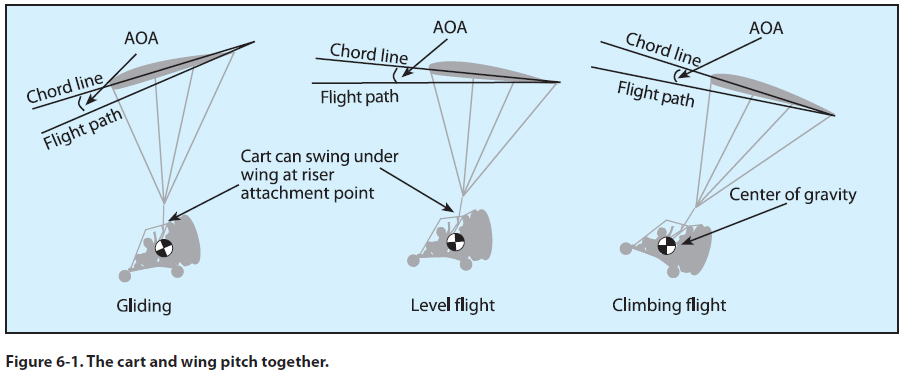|

The Four Fundamentals
There are four basic flight maneuvers upon which all
flying tasks are based: straight-and-level flight, turns,
climbs, and descents.
In addition, the powered parachute (PPC) has a
unique characteristic, the pendulum effect, as covered
in Chapter 2. This chapter will cover the basic flight
maneuvers and how they are influenced by this pendulum
effect.
Flight Controls
The PPC has two basic flight controls:
1. Throttle: used to adjust the vertical speed to
climb or descend
2. Steering controls: used to turn right or left
The wing design, angle of trim, and total weight determine
the PPC airspeed, which remains about the
same for most flight operations.
The vast majority of PPC steering is done via either
foot pedals or foot steering bars. However, some PPC
designs incorporate hand steering controls. In addition
to the mechanical hand or foot steering controls, the
steering line itself can be pulled directly or in combination
with the mechanical controls. For simplicity
of the information in this handbook, flight steering
controls will be addressed as foot controls. For those
PPCs with hand steering controls or steering lines that
are pulled directly, substitute “push the foot steering
control” with “pull the hand steering control” or “pull
on the steering line.”
Throttle
While in the air, the throttle provides thrust and therefore
controls altitude; it is used to climb and descend.
Throttle changes will not measurably affect your airspeed.
The aircraft maintains about the same indicated
airspeed throughout your pitch angle and altitude
changes. There is less than a 1 MPH increase in speed
as the throttle is increased from gliding flight to level flight; not easily measured on the instruments or felt
by the pilot in the air.
Pitch angle changes in a PPC are similar to pitch
changes in an airplane being flown at a constant airspeed.
Assuming a typical 3-to-1 glide ratio for a powered
parachute, the pitch increases about 20 degrees
from gliding flight to level flight. The pitch would
increase an additional 20 degrees from level flight to
full power climb, assuming a three-to-one climb path
with a high powered engine. This total pitch change
of 40 degrees from glide to high powered climb is
significant and noticed by the pilot, passenger, and
observers on the ground. Throughout the large pitch
variations of the PPC, the PPC will continue to fly at
about the same airspeed, even with the engine off.
As you descend with the throttle retarded, the nose of
the cart is pointed more towards the ground while the
wing is overhead. As you climb, the nose of the cart
is pointed more towards the sky, and the wing appears
to be rotated in back of you. These are large pitch
changes. A common misunderstanding is that these
pitch changes, which can be as much as 40 degrees,
are a change of angle of attack. This is not the case.
The angle of attack stays almost constant for the same
weight and the same speed, but the pitch angle, especially
as viewed from the cart, changes dramatically.
On a PPC, the angle of trim is determined by the
suspension lines and set at the factory, but the cart
can rotate around the riser attachment point to the
cart. Generally, the angle between the cart and the
wing remains the same; both pitch together rotating
around the center of gravity of the complete aircraft.
[Figure 6-1]

Flying in good atmospheric conditions and using
smooth throttle applications can avoid additional
loading which results in slight increases in angle of
attack and speed.
A common, inappropriate use of the throttle is an
abrupt power application when the engine is at idle.
This abrupt application of throttle from idle to full creates a porpoising effect. Gradually increase the
throttle to full to avoid the abrupt porpoising.
|

